#North American pollinators
Photo
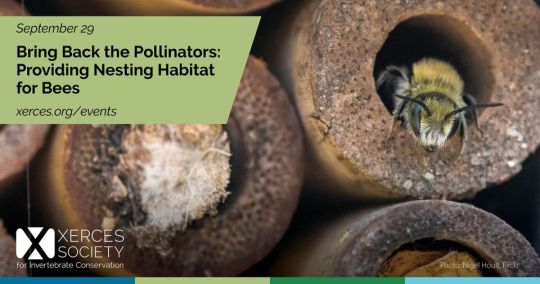
Upcoming webinar:
Bring Back the Pollinators: Providing Nesting Habitat for Bees
September 29: 10:00 AM - 11:00 AM PT / 11:00 AM - 12:00 PM MT / 12:00 PM - 1:00 PM CT / 1:00 PM - 2:00 PM ET
The availability of nesting habitat is a critical yet often overlooked factor impacting native bee populations. In this webinar, Xerces Biologists, Leif Richardson and Sarah Foltz Jordan, will summarize nesting biology of major groups of bees, including leaf-cutter bees, mining bees, bumble bees, and many more.
They will also offer numerous practical approaches to creating and managing nesting habitat features. Approaches are relevant to landscapers, farmers, gardeners, natural resource professionals, and anyone interested in taking the next step in supporting pollinators. Community science opportunities will also be discussed.
Register: https://xerces.org/events/none/bring-back-pollinators-providing-nesting-habitat-for-bees
This is the fourth webinar in the four-part series Bring Back the Pollinators.
This webinar will be recorded and available on our YouTube channel. Closed Captioning will be available during this webinar.
#bees#bee#bee conservation#north american bees#north american native bees#native bees#conservation#habitat#nature#north america#pollinators#savethepollinators#animals#science#ecology#endangered#environment#gardens#gardening#land management
331 notes
·
View notes
Text

Bombus pensylvanicus on Rhododendron x 'Conlec' / American Bumblebee on Autumn Royalty Azalea
#Bombus pensylvanicus#Bombus#apidae#Rhododendron x 'Conlec'#Rhododendron#ericaceae#American Bumblebee#Bumblebee#Bumblebees#Bee#Bees#Autumn Royalty Azalea#Azalea#azaleas#Native pollinators#Native bees#Pollinators#Native plants#Native flowers#Flowers#Nature photography#photographers on tumblr#Durham#Durham NC#North Carolina#Home
9 notes
·
View notes
Text
Goldenrods
It’s nowhere near the fall hayfever season, but I thought I’d PSA anyway.
Hayfever is caused by RAGWEED (Ambrosia artemisiifolia and Ambrosia trifida where I live).

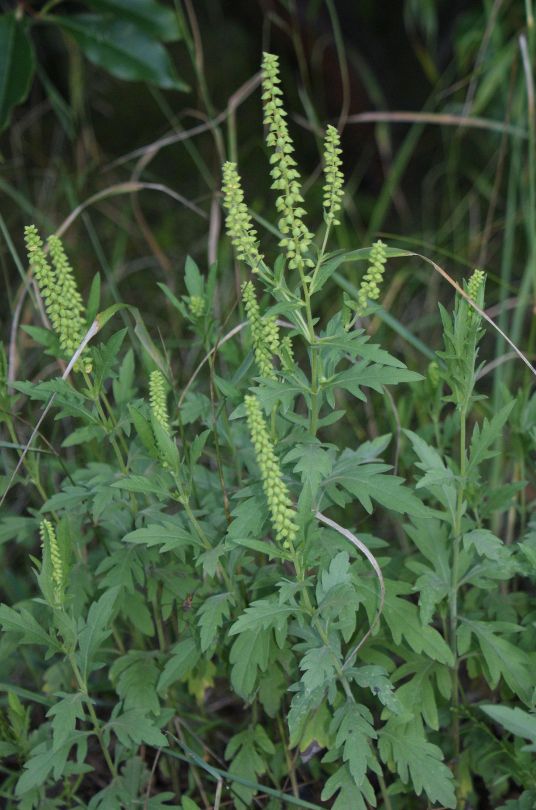
NOT. Goldenrod (Solidago, Oligoneuron, Euthamia). It is impossible for goldenrods to even cause hayfever since their pollen isn’t released to the wind. Goldenrods are beautiful, with some edible parts, some medicinal properties, and middle of summer through fall pollenators love them.
Non-exhaustive list of goldenrods
Euthamia graminifolia (Flat-top goldenrod):

Oligoneuron rigida (Stiff goldenrod):

Solidago bicolor (Silverrod):

Solidago caesia (Blue-stem goldenrod):
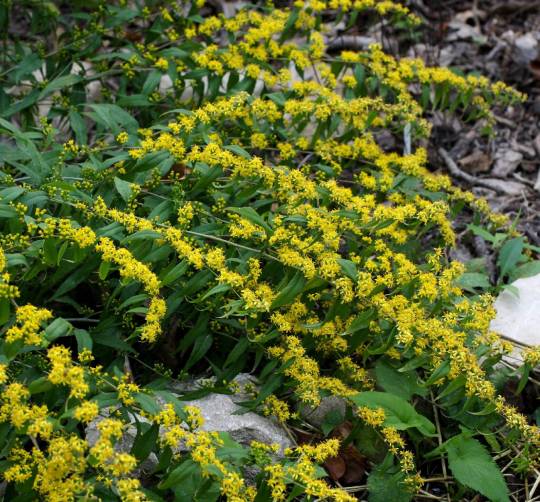
Solidago canadensis (Canada goldenrod):

Solidago flexicaulis (Zigzag goldenrod):

Solidago juncea (Early goldenrod):
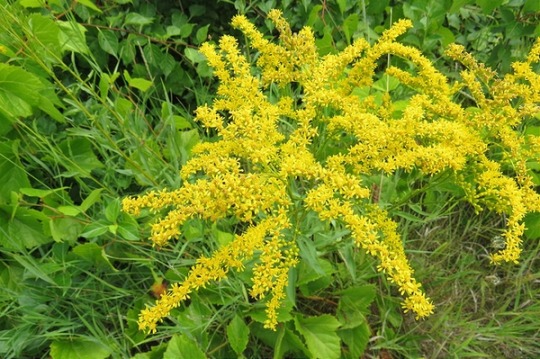
Solidago missouriensis (Prairie goldenrod):
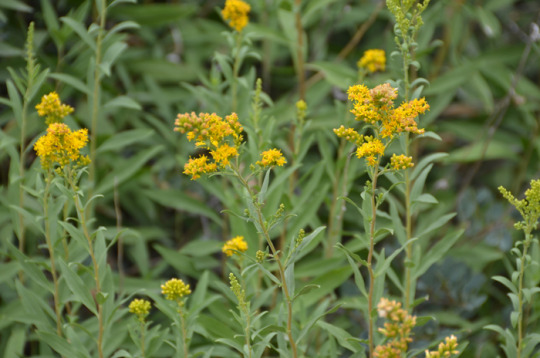
Solidago multiradiata (Alpine goldenrod):

Solidago nemoralis (Gray goldenrod):

Solidago odora (Anise-scented goldenrod):

Solidago ohiensis (Ohio goldenrod):

Solidago patula (Rough-leaf goldenrod):
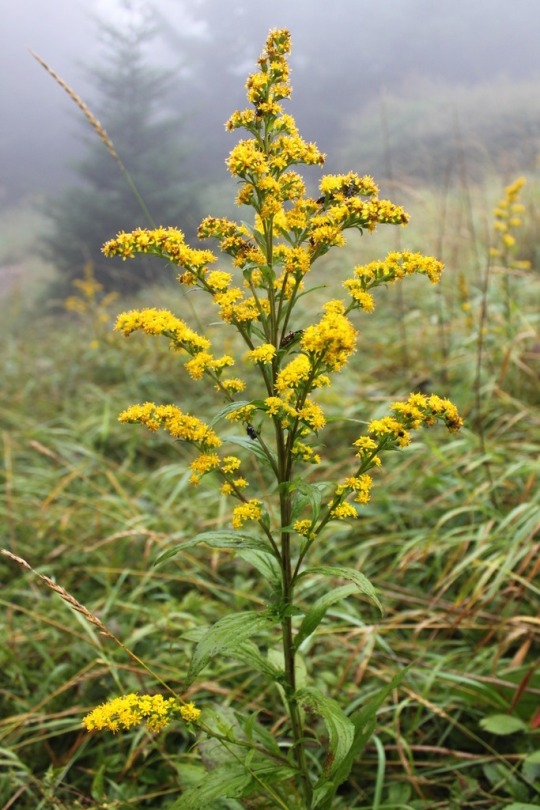
Solidago ptarmicoides (Upland white aster):

Solidago rugosa (Wrinkleleaf goldenrod):
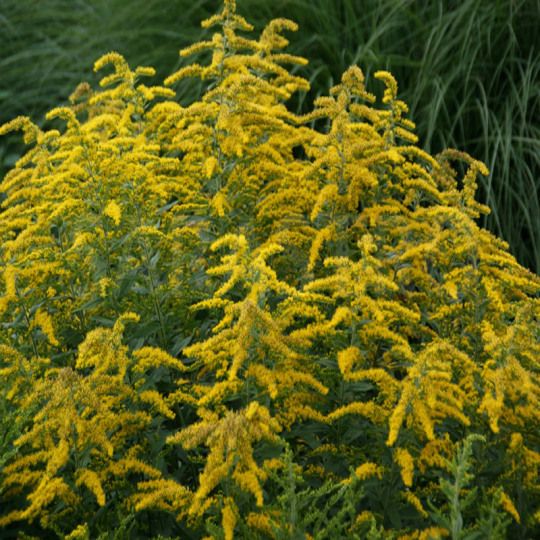
Solidago simplex (Spike goldenrod):
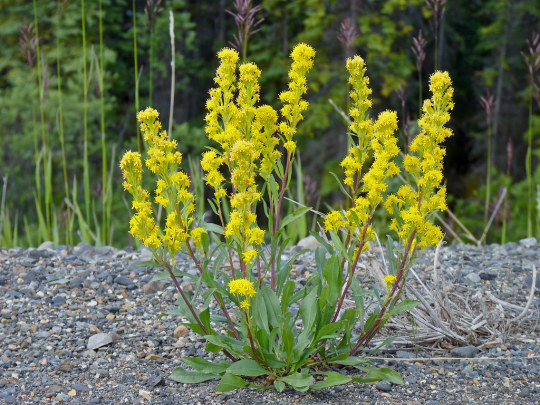
Solidago speciosa (Showy goldenrod):
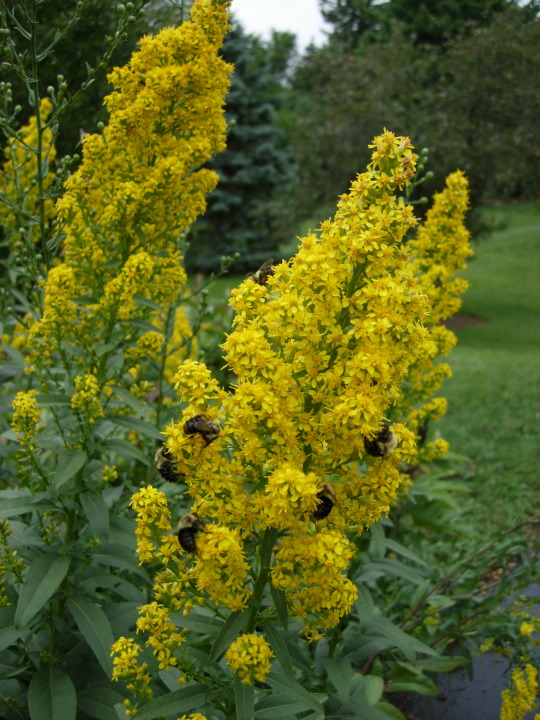
Solidago uliginosa (Bog goldenrod):
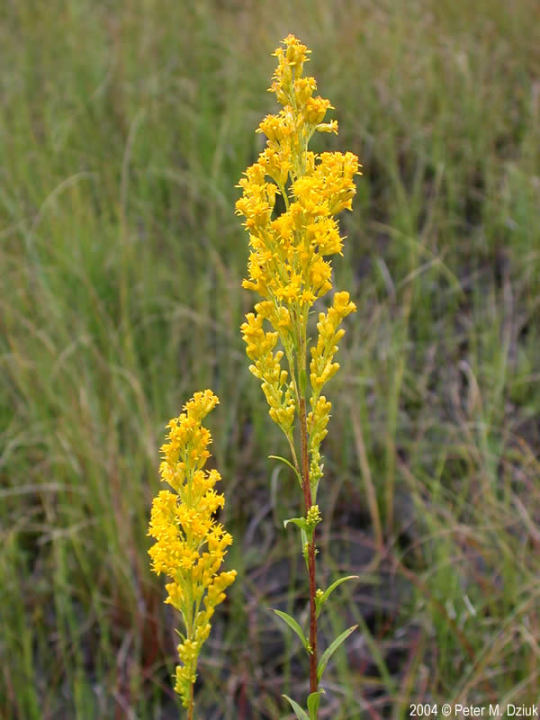
The only drawback is that many goldenrod species spread a lot and quickly if you don’t keep on top of those rhizomes. But if you need to fill a space in a relatively short period of time, why not try some in your garden? They’ll grow up green through spring and summer and put on a show in the fall (earlier depending on the species)!
#long image post#goldenrods#hayfever#ragweed#Ambrosia#Solidago#Oligoneuron#Euthamia#flowers#yellow flowers#native species of North America#North American native plants#pollinator plants
18 notes
·
View notes
Text

Some Pollinator Appreciation
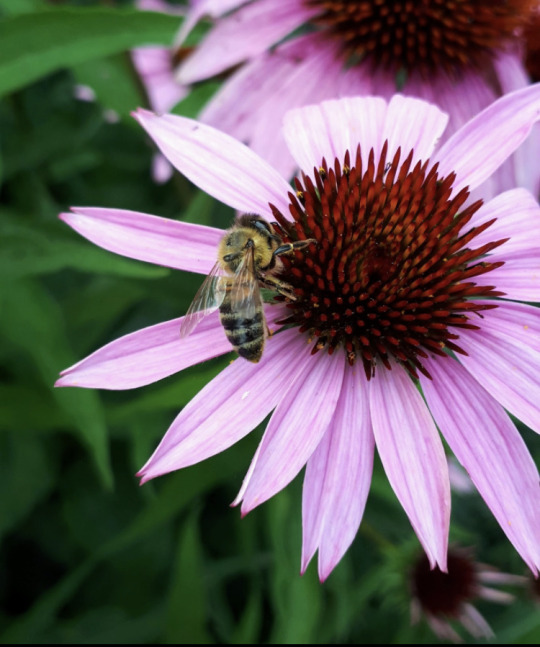

#flowers#bees#wasps#bumblebees#honeybees#insects#nature#entomology#I didn’t know purple coneflowers were native wildflowers to NA very cool#all of these are very common species but it’s still nice to see#there are more than just hymenopteran pollinators of course#purple echinacea#bombus impatiens#apis mellifera#apidae#dolichovespula arenaria#common aerial yellowjacket#vespidae#hymenoptera#north american species#introduced species#my photos
6 notes
·
View notes
Text
Loving reminder from your land history auntie:
North American golf courses have had 50-100 years of arsenic and mercury based fungicide and herbicides applied to their soils.
Do not eat anything that has been grown on a golf course or downstream from a golf course. I know it sounds cool and radical, but you are too valuable to poison yourself with heavy metals.
Protect each other, turn your local golf course into a pollinator garden, not a sex forest or community garden.
#i am over here worrying about all you kiddos#also please dont forage on railway corridors either#love yourselves protect yourselves#lmao at the replies saying 'but why not sex forest anyway'#you do you kids#im personally a no thank you on the lead arsenic mercury sex forest personally#if you havent seen it there's a popular book about making golf course a sex forest#that isn't a random pull
57K notes
·
View notes
Text
dandelion facts:
Stories about dandelions can be found in folklore almost worldwide!
Dandelions have a diuretic effect (they make you pee,) which is reflected in some of their common names (piss-a-bed)
most North American dandelions reproduce asexually by apomixis, creating loads of identical daughters!
Since they reproduce asexually, these dandelions don't need to be pollinated, even though they produce lots of pollen and nectar. The dandelions that pop up in a lawn feed pollinators without receiving any benefit for themselves.
Dandelion seeds can sprout at any temperature between 0 and 36 degrees Celsius!
Dandelions can regenerate themselves from just a piece of their taproot!
dandelions have a near worldwide distribution and were introduced to North America as a food crop!
Dandelions grow bigger and produce more viable seeds in conditions of higher carbon dioxide, suggesting that human-caused carbon emissions are good news for the dandelions!
Dandelions have been shown to pass epigenetic changes to their DNA caused by stress to their offspring.
4K notes
·
View notes
Text
Creature Awaits #165
Each week I plan to feature an amazing creature, admiring God's fantastic artistry. Hopefully it’ll brighten someone’s day to see something new and interesting if they haven’t seen it before. : )
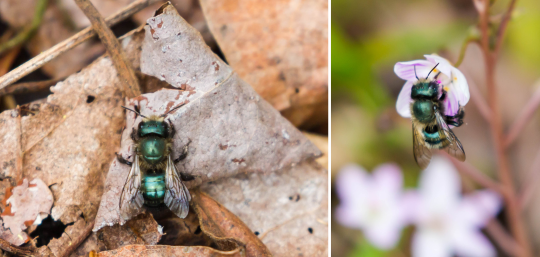
(Beautiful photography by Melissa McMasters (CC BY 2.0))
The Orchard Mason Bee
A.K.A: The Blue Orchard Bee (From photographs, it looks like their body is a metallic dark blue, but reflects a bright green in sunlight. : ) )
Scientific Name: Osmia lignaria
Region: North America
Size: Males are about 0.43" (~11mm) long, whereas females are about 0.55" (~14mm) long
Interesting Notes: As with other mason bees, their stinger is primarily for placing eggs. They're a shy species that will only sting if they sense great danger. Though they will build nests close to others and act friendly towards them, each family will take care of only their own brood, rather than having a queen/worker bee societal structure.
#creatureawaits#Orchard Mason Bee#Blue Orchard Mason Bee#Blue Orchard Bee#Osmia lignaria#beautiful bees#iridescent bees#metallic bees#pollinators#mason bees#solitary bees#North American bees#hide
1 note
·
View note
Text



Salix discolor (American pussy willow)
The catkins of this pussy willow (Salix discolor) is another sure sign of early spring and they're the only flower I can think of that wears a fur coat. Pussy willows use these silky fibers as insulation to keep their catkins protected in late winter. This species is native to North America in a wide band that runs, coast-to-coast, through southern Canada and the northern lower United States.
Plants know when to flower by measuring the air temperature and the length of day. A brief warm period in the winter will not be enough for pussy willows- they need longer days too. Then, when the timing is perfect - boom they bloom!
As with so many spring flowering trees, willows produce flowers before they leaf-out. Male and female catkins grow on different plants. The appearance of yellow anthers indicates that this one is a boy and it's just about to start producing pollen. Willows are insect-pollinated and this means that hungry worker bees will soon wake up and these pussy willows will immediately get their full attention.
#flowers#photographers on tumblr#pussy willows#spring flowers#catkins#fleurs#flores#fiori#blumen#bloemen#Native plants#my garden#recommendation: "What a plant knows” by Daniel Chamovitz#Vancouver
83 notes
·
View notes
Text
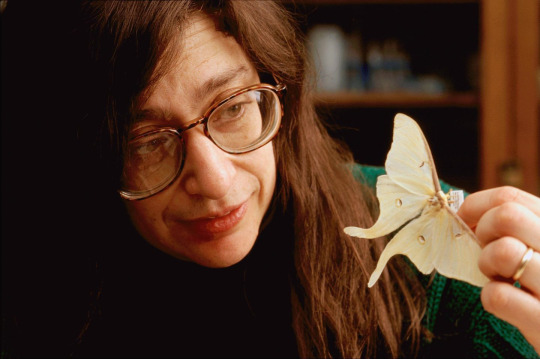

Notable Women in Zoology: Professor May Roberta Berenbaum
An American entomologist with a research focus on chemical communication between herbivorous insects and their host plants, as well as the implications of these interactions on the organisation of communities + the evolution of species.
She is also:
A member of the National Academy of Sciences (and editor-in-chief of its journal, Proceedings of the National Academy of Sciences)
Previously served as the editor of Annual Review of Entomology (1997-2018)
A member of the American Philosophical Society
A fellow of the American Academy of Arts and Sciences
Serves as the head of the Department of Entomology at the University of Illinois
Holds the Maybelle Leland Swanlund Endowed Chair in Entomology (highest title a professor can hold at the University of Illinois)
Awarded the National Medal of Science in 2014
Chaired the Committee on the Future of Pesticides in U.S. Agriculture (2000) and the Committee on the Status of Pollinators in North America (2007)
Has written numerous magazine articles + books about insects for the general public
Organiser of the Insect Fear Film Festival at the University of Illinois
Dr. Bambi Berenbaum, famous entomologist and love interest of Agent Mulder in The X-Files, is named after her
74 notes
·
View notes
Text
February 2nd, 2024


Thick-legged Hoverfly (Syritta pipiens)
Distribution: Native to Europe, but found throughout Eurasia and North America.
Habitat: Occur wherever there are flowers, but most common around human habitations; common habitats include farmland, gardens and parks. Larvae are most common in rotting organic matter such as compost, manure, silage, and occasionally cadavers.
Diet: Larvae feed on decaying organic matter, while adults feed on many types of flowers. Their most common food plants are water-willow, white vervain, American pokeweed and candyleaf.
Description: The thick-legged hoverfly is called so due to their overdeveloped hind legs. These insects can sometimes be pests, as they occasionally feed on ornamentals, but are generally considered beneficial because they pollinate many common flower species. They also act as bio-indicators, especially to demonstrate the effects of environmental changes on pollinators.
Hoverflies are very agile fliers, and are often found hovering near flowers. This species, however, is very rarely found flying more than a metre above ground level. When they encounter another fly, males will sometimes circle around them; if they're male, this often results in the two males circling eachother, and if they're female, the male may dive at her at an acceleration of up to 500 centimetres per second squared in an attempt to initiate copulation.
Images by Joaquim Alves Gaspar and Stephen Luk.
65 notes
·
View notes
Text
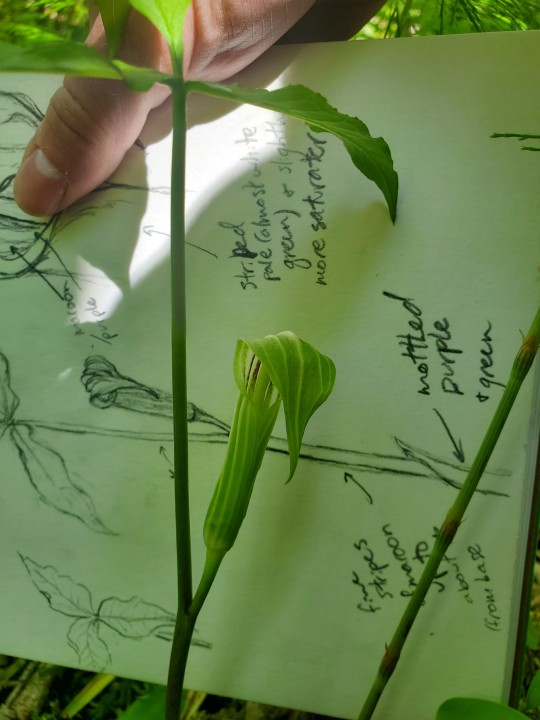

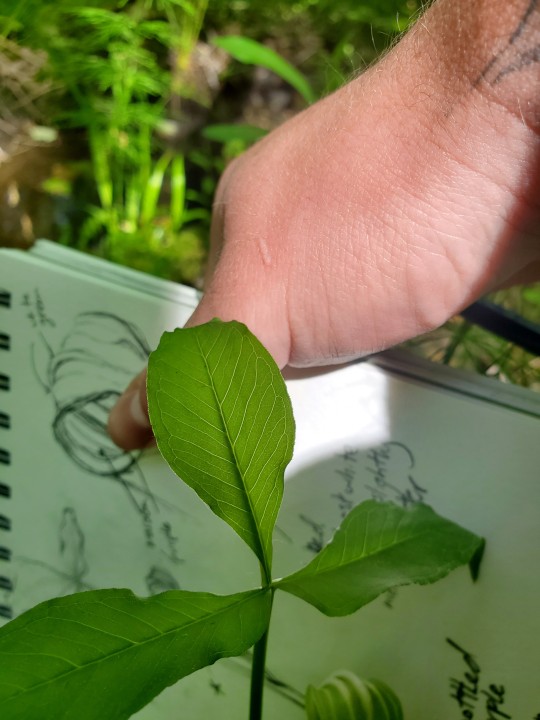
Today's plant is Arisaema triphyllum, also known as Jack-in-the-Pulpit. (photos are mine)
A. triphyllum is actually a species complex of four (or five, depending on who you talk to) closely related species. All species are native to Eastern North America and are found in deep, moist soils rich in organic matter. This group is still undergoing lots of debate in the taxonomy world, and the exact grouping and lineages are not fully known.
This species complex is part of the family Araceae, which is an incredibly cool (in my opinion) and diverse family that predominantly lives in the tropics of South American and eastern Asia.
Like most of its relatives, it attracts pollinators (at least in part) through deceptive scent compounds, which are volatilized and spread under exposure to heat. Unlike many of its relatives, Jack-in-the-Pulpit does not appear to utilize thermogenesis (active metabolic heat production) in its flowering parts to achieve this--it is posited that absorbed heat from the sun is sufficient for them to release these compounds! (Barriault et al. 2009)
Another trait it shares with almost all of its relatives is a very particular defense strategy: tiny, tiny knives. Its shiny red fruits might look tasty to some, but beware: the sensation of biting into it has been described by those brave (read: foolish) souls who've tried it as "like chewing glass."
This sensation is caused by tiny daggers of crystalline calcium oxalate (called raphides) being forcibly ejected from their cells right into your tender mouth parts by the force of your own chewing. Now that's what I call retribution!
76 notes
·
View notes
Photo
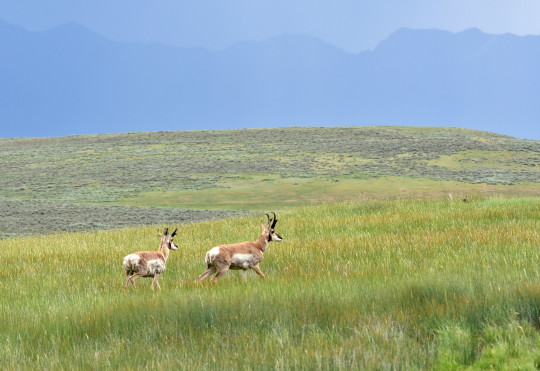

Conserving and Restoring North American Prairie
Home to hundreds of species of birds, mammals, fish, reptiles, amphibians, and pollinators, grasslands are unsung heroes. Alongside providing a haven for wildlife, this iconic landscape sequesters carbon, reduces soil erosion, ensures clean water, protects biodiversity, and more.
You might be asking yourself how we could live without the countless benefits grasslands provide us and wildlife, and the answer is - we probably wouldn’t be able to for very long.
We have lost more than 50 million acres of the landscape in the last 10 years due to climate change, agricultural conversion, invasive species, and other threats. This map can help guide voluntary conservation in this critical landscape - help us help each other keep the green areas green and restore the yellow and purple areas.
Learn more: http://ow.ly/nHQ550M4GJL
606 notes
·
View notes
Text
Red dead gang + flowers
Arthur Morgan - Dudleya cymosa; Canyon liveforever, native to California cliff faces and craggy areas, thrives in the sun and blooms vibrant red and orange cymes. Pointed rosettes of succulent leaves form the base which sends out a delicate bloom in early summer. This flower is also the one found in the terrarium jar on Arthur's bedside table.
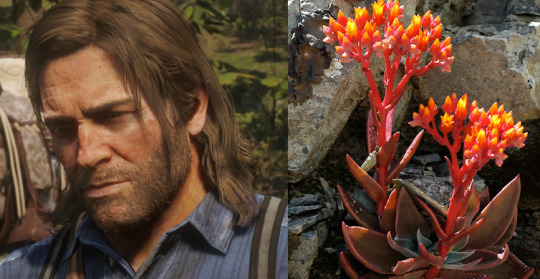
Tilly Jackson - Helianthus annuus; Common sunflower, a showy plant native to grasslands in the US, its undomesticated form is a branching annual plant with many flower heads. Its domesticated form is an important food crop grown both for its seeds and seed oil. It's common in sunny gardens, where its unmistakable bright blooms attract pollinators. Commonly symbolizes longevity and adoration.

Sean Maguire - Tripolium pannonicum; Sea aster, native to Ireland, a very hardy plant that requires very little to thrive. Showy purple blooms usually a bit ruffled, but all the brighter in their seaside environments.
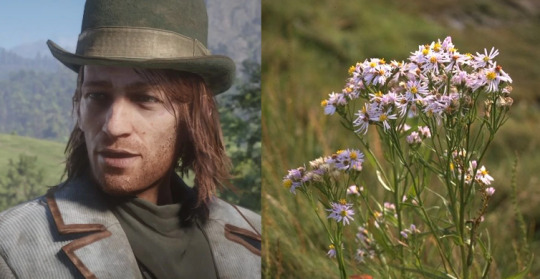
Charles Smith - Quercus alba; White oak, a staple crop for thousands of years, white oaks of the Quercus genus are amongst the most important habitat species for wildlife in North America. These trees provide food, shelter, fuel, and fertilizer for countless native flora and fauna, and oaks are among the few trees that thrive in both open fields and sheltered forests. Their diminuitive flowers (catkins) are wind pollinated and mature into thousands of acorns per tree every 2-10 years. Traditionally associated with bounty, wisdom, and protection. (Not a flower in the traditional sense, but catkins do count and white oak really REALLY suited Charles so I'm putting this in)
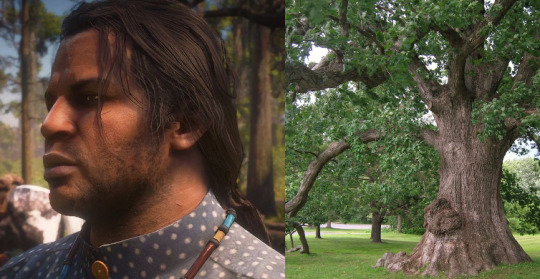
Dutch Van Der Linde - Pueraria montana; Kudzu vine, a hardy, subtropical plant introduced to the US with bright sweet pea flower spikes in spring. Rapidly spreads to completely cover native flora, shading out and crushing plants and depleting habitat for mutualistic wildlife. This vine is a noxious invasive in the southern US.
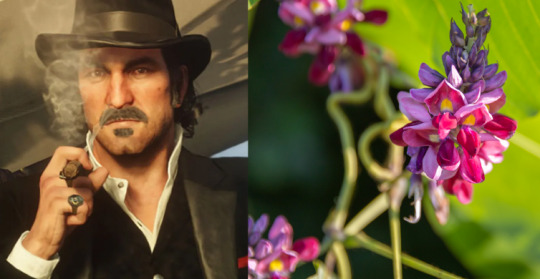
Hosea Matthews - Triticum aestivum; Wheat, grown as a staple crop around the world, wheat has many uses and is considered the backbone of western cuisine. Often grown in wide monocrop fields, mature wheat's golden color makes for a striking image. Commonly symbolizes bounty and resurrection. (Yes, grass (Poaceae) is a flowering plant family!)

Mary-Beth Gaskill - Viola riviniana; Common dog violet, native to europe, its nodding purple blooms can be found along roads and creeks in lightly shaded areas. Flowers in this genus traditionally symbolize modesty and humility.

Abigail Roberts/Marston - Rudbeckia hirta; Black-eyed Susan, a popular midwest native wildflower common in gardens for its sunny florets and contrasting center. Its association with gardening is a long established one, and traditionally symbolizes encouragement, adaptability, and determination.
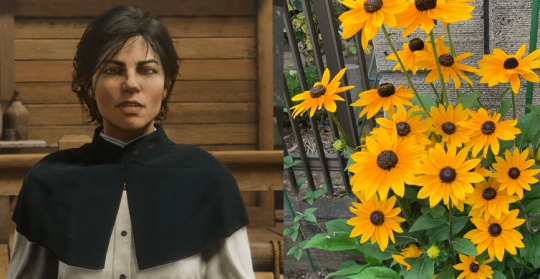
Molly O'Shea - Passiflora alata; Winged-stem passionflower, a species native to the south American tropics and known for its visually distinctive red petals and exotic striped filaments. A delicate looking nodding flower with an edible fruit, commonly cultivated for its medicinal benefits and its beauty.
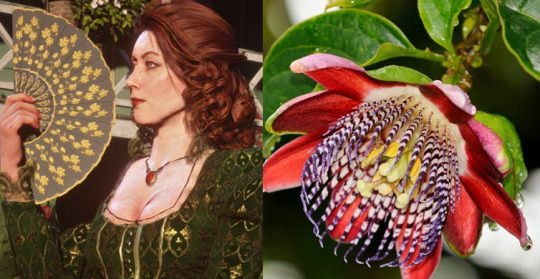
This post got very long! I will make a part two to save you the effort of scrolling <3
#rdr2#Red Dead Redemption 2#Botany#Long post#Arthur Morgan#Tilly Jackson#Sean Macguire#Dutch van der Linde#Hosea Matthews#Mary Beth Gaskill#Abigail Roberts#Molly O'Shea#*combines my two special interests*
324 notes
·
View notes
Text
Species You Didn’t Know Weren’t Native to North America
There are some species found here in North America that are so common that many people just assume they’re part of the native menagerie. They’re naturalized, which means they’re non-native but have managed to establish reproducing populations here. Some may also be considered invasive, in that they aggressively compete with native species and may even displace them in some places.
I know some of you readers will already be familiar with the fact that the following species aren’t native here. But I bet there’ll be surprises for the rest of you! Let’s see who our not-actually-natives are.

Ring-necked Pheasant (Phasianus colchicus)
Hunters across the continent have long hunted pheasants for the table. First introduced in 1773–exactly 250 years ago–they have since made themselves at home in fields and meadows. While the largest populations can be found in the Midwest, especially the Great Plains states, they can be found throughout the United States, with additional scattered populations in southern Canada and Mexico.
While sometimes assumed to have integrated into their introduced habitats, pheasants actually wreak havoc on native game birds like quail and grouse. They compete for suitable food and nest sites, and may also practice nest parasitism, laying their eggs in other birds’ nests. This competition has led to decreases in native bird populations, as has the spreading of diseases that the pheasants tolerate, but which decimate other species. Pheasants will even attack and kill other birds.
So what other species made the list? Keep reading to find out!
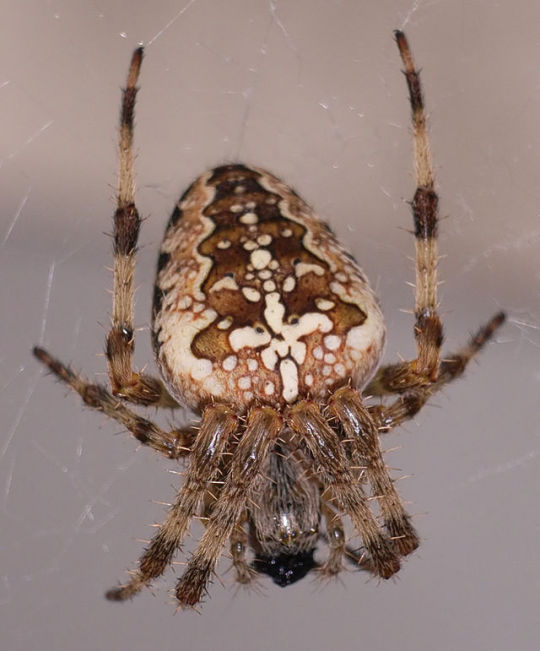
Cross Orb Weaver (Araneus diadematus)
Fall is cross orb weaver time, and I run into these spiders constantly–sometimes literally, depending on how inconveniently their webs are placed! By that time of year, they’ve grown large enough to be noticeable, and their orange and brown coloration looks rather festive.
While I haven’t been able to find any indication that these spiders have a deleterious effect on their introduced ecosystems, they likely put at least some pressure on local invertebrate populations, whether as predators or competitors for prey species. This may become more pronounced as continued overuse of pesticides and habitat loss contribute to the invertebrate apocalypse.
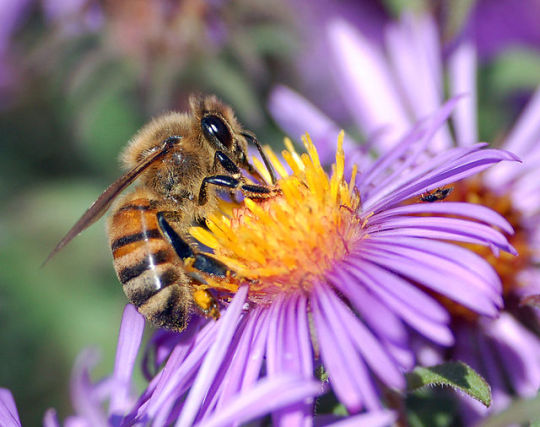
Honey Bee (Apis mellifera)
“Save the bees!” has been an increasingly common headline since Colony Collapse Disorder first became widely known among the general public almost twenty years ago. What the articles rarely mention is that the honey bee is actually a domesticated insect that originated from wild stock in Europe. In fact, the true wild honey bee may be close to extinction, another victim of its domesticated descendants.
In fact, honey bees cause the decline of wild bee species wherever they are introduced. Not only do they compete with wild bees for food and nest sites, but they also spread diseases and parasites to these other species, some of which have become quite scarce. Moreover, honey bees are less effective at pollinating native plants outside their own range, and these species are at risk of extinction if their native pollinators are out-competed.

Another invertebrate beloved of gardeners here, the earthworms actually consist of a mix of both native and non-native species. Unfortunately, many native earthworms went extinct during the last Ice Age, so if your area has a recent glacial history it’s likely that the worms in your garden are invasive. (That does include the red wigglers (Eisenia fetida) commonly used for vermicomposting.)
What damage can a bunch of worms do? Plenty, as it turns out. They speed up decay and mix up nutrients in the soil in ways that many North American ecosystems aren’t used to. This changes physical characteristics of the soil like pH, texture, and density, as well as distribution of nutrients. Some young plants may not be able to reach nutrients that worms have moved deeper underground. So while you may thank earthworms for aerating the soil in your garden, they’re more of a problem for a lot of native ecosystems here.

umbleweed (various species)
“Drifting along with the tumbling tumbleweeds,” sang the Sons of the Pioneers in 1934, though tumbleweeds have been associated with the American West for much longer. Several species of plant dry out, snap off the root system, and roll along the ground spreading the mature seeds. The best-known species is the Eurasian Kali tragus, though there are other species that have been introduced here.
Because these plants take up a lot of physical space, they can crowd out native plants, especially those that are not shade-tolerant. Their seed distribution method means that one plant can spread its descendants many miles from where it originated. Moreover, the masses of dead, dry tumbleweeds can build up and become wildfire fuel.

Red Clover (Trifolium pratense) and White Clover (Trifolium repens)
These two plants are so ubiquitous that it’s easy to assume they’ve always been here. White clover is especially common in lawns, and red clover will pop up in just about any disturbed sunny spot. Both are native to Europe and Asia, and red clover additionally may be found in North Africa. However, both species have been widely introduced elsewhere.
While neither is considered particularly invasive, they can take over large areas of disturbed land. They are deliberately sown for cover crops and livestock forage, so they’re not likely to go away any time soon.
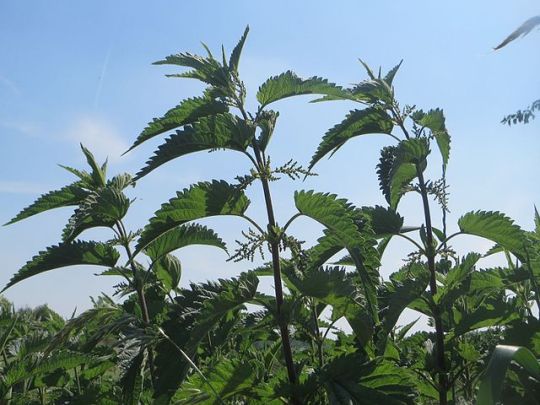
Stinging Nettle (Urtica dioica)
This is one of the most popular spring plants for foragers; chemicals that cause irritation can be removed through soaking the plants in water or cooking them. Although stinging nettle grows well in large areas of the United States, Mexico, and southern and western Canada, it is actually native to northern Africa, Europe, and Asia.
Stinging nettle makes itself at home in forested settings in particular. While it doesn’t create the same sorts of monocultures that, say, Himalayan blackberry does, it can shade out smaller plants with its broad leaves.
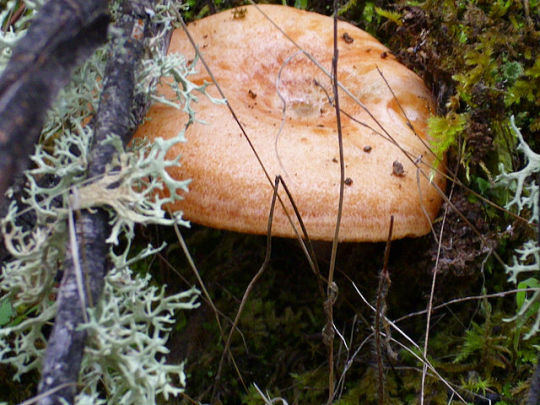
Saffron Milkcap (Lactarius deliciosus)
People don’t often think of fungi when it comes to non-native and invasive species, and yet there are fungi that have been moved around to new areas, often with their partner plants. Some are tiny soil fungi, but there are those that produce visible fruiting bodies. The edible saffron milkcap is one of these. It is mycorrhizal with pine trees in its native Europe, and managed to form connections with pines in North America as well.
As saffron milkcap does not cause any known diseases of plants, it is not considered an invasive species in the way that chestnut blight (Cryphonectria parasitica) is. While the mycelium of saffron milkcap may certainly compete for some of the same soil nutrients as native species in the same area, it has not become aggressive enough to displace native fungi.
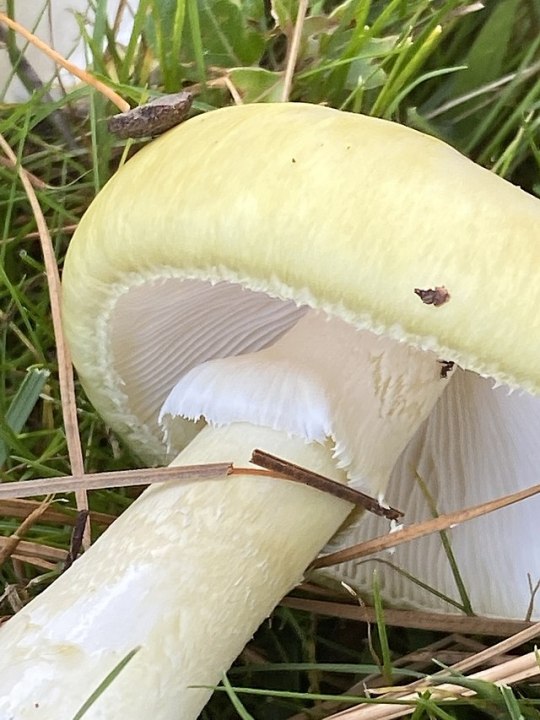
Death Cap (Amanita phalloides)
There are large, white Amanita species native to North America, like A. ocreata and A. bisporigera, both known colloquially as “destroying angels.” The death cap, however, is native to Europe. It has been spreading through parts of the United States, particularly along all the coastlines, and may sometimes be yellow-tinted. Its close cousin, the European destroying angel (A. virosa), has made a few appearances in New England and southern Quebec according to iNaturalist’s map of research-grade observations.
While these invasive Amanitas do not cause widespread ecological damage, they are considered invasive due to their extreme lethality. One cap is sufficient to kill a healthy adult human being.
Did you enjoy this post? Consider taking one of my online foraging and natural history classes or hiring me for a guided nature tour, checking out my other articles, or picking up a paperback or ebook I’ve written! You can even buy me a coffee here!
#CW spider#spider#animals#plants#fungi#wildlife#nature#invasive species#native species#biodiversity#ecology#conservation#environment#gardening#weeds#foraging#mushroom hunting
55 notes
·
View notes
Text
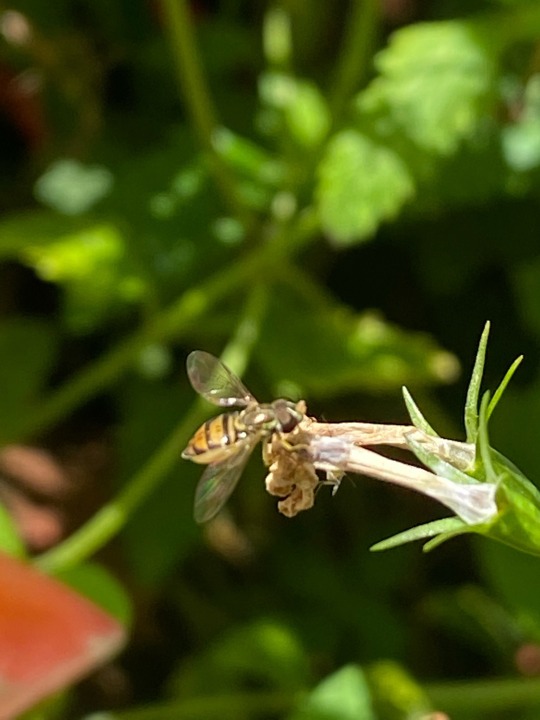

Another lovely calligrapher fly in the garden 🪰
#toxomerus marginatus#calligrapher fly#hover flies#flies#flowers#entomology#pollinators#bugs#syrphidae#diptera#north american species#my photos
4 notes
·
View notes
Text
North American friends, please don’t mistake UK “let our native weeds grow freely” as blanket permission to claim US non-native weeds as equally beneficial. They don’t have the same value to our native pollinators
No Mow May is a huge case study on cross-Atlantic mistranslation
Listen to Dr. Sheila Colla, NA native bee expert, instead of UK honeybee people:
“Coming back from the biodiversity crisis will require active stewardship, not neglect, of altered landscapes.”
I permanently keep this article open as a tab on my phone because I reference it so much
yes, something flowering is better than nothing, but all this money, research, PR, and literal seeding of weeds going on could instead be used to support our actual native bees, instead of offering them non-native, poorly nutritious diets that can literally lead them to canibalize their own eggs
3K notes
·
View notes